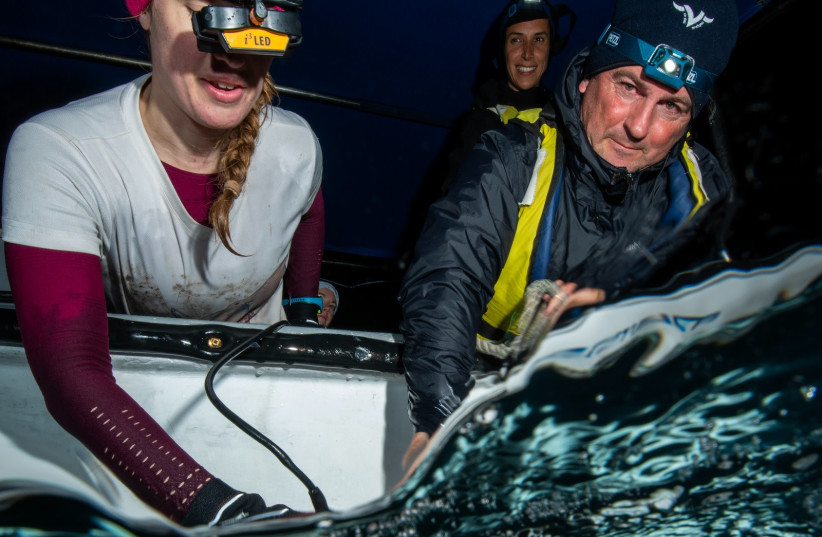The families of Israeli hostages Fernando Marman (61) and Louis Har (70), who were rescued in Rafah this week by brave IDF soldiers after the two were held by Hamas terrorists for 129 days, were warmly welcomed by their family, friends and many Israelis. And now, two sharks identified off the Mediterranean coast by a team of researchers from the Morris Kahn Marine Research Station of the Charney School of Marine Sciences at the University of Haifa have been named in the former captives’ honor.
The two men had lost a lot of weight, according to family, who said that they ate mostly white cheese and pita bread while in captivity and were taken hostage from Kibbutz Nir Yitzhak with members of their family.
Just before the stormy weather expected this weekend, the researchers identified a dusk shark (Carcharhinus obscurus) and a sandbar shark (Carcharhinus plumbeus). They were given names “Fernando” (a male) and “Louisa” (a female) by Dr. Aviad Scheinin, head of the university’s Marine Apex Predator Lab that specializes in conservation, behavioral science, and long-term ecological research of coastal dolphins, sharks, rays, and bluefin tuna.

The dusky shark, more than four meters long and weighing around 350 kilos, lives in temperate and tropical seas around the world. A generalist apex predator, the dusky shark has been recorded from a depth of 400 meters under the surface. They can swim hundreds to thousands of kilometers seeking food. With a short, round nose and a slender, streamlined body, they have a ridge between the first and second dorsal fins and lightly8 marked fins.
The adults from age 20 eat bony fish, sharks and rays. crustaceans, sea stars, sea turtles, marine mammals, carrion, and garbage. Females can store sperm for long periods, as their encounters with suitable mates may be quite infrequent due to their nomadic lifestyle maturing sharks, not reaching adulthood until around 20 years of age.
Also known as the thick-skin shark, the sandbar shark is native to the Atlantic Ocean and the Indo-Pacific. They are easy to identify by experts because of their very high first dorsal fin and interdorsal ridge. They are closely related to the dusk shark and very large, swimming alone or in sex-segregated schools that vary in size.
Apex predators are important for maintaining the integrity of ecosystems, yet there exists a huge knowledge gap on these predators of the Eastern Mediterranean Sea. The University of Haifa’s lab is continuously engaged in developing new sampling protocols and indicators for pelagic megafauna. Emphasis is placed on the function of these species as sentinels of the marine environment and their ability to inform us about human perturbations.
They use photogrammetric measurements using drones and unmanned aerial vehicles; active and passive acoustic surveying techniques; mark-recapture methods; underwater observations; and cutting-edge technologies for molecular and stable isotope analyses; and microbiome analysis. The shark-tagging study is part of a long-term ecological study conducted for the ninth year on the super carnivore population in the Eastern Mediterranean, where sharks are an important part of the fabric of life in the sea.
During the winter, sharks congregate in the warm waters in the Hadera, Ashdod and Ashkelon areas, and so far, most of the research has been carried out at the outlet of the warm water at the Orot Rabin power plant in Hadera, during which 109 sharks have been tagged.
Until last weekend, 71 dusk sharks had been tagged, most of them females, and 38 fin sharks, most of them males. Now, there is one more of each. “Louisa the Sandbar Shark’s arrival in our area is a relatively rare and very exciting event. Sharks are in danger of extinction in the Mediterranean Sea. Receiving the acoustic tag allows us to examine her movement along the coast of Israel and to understand more deeply what their motivation is to reach the warm waters and check whether she will return to the area. This is also in the years to come,” said Scheinin.
In the coming years, following the winning of National Geographic grants, the Kahn Marine Research Station’s research was expanded to Turkey, Italy, and Albania, while collaborating with local shark researchers. During the research, the researchers come to training in Israel to learn how to tag a shark correctly and safely.
“Having shark research in the shadow of the difficult war is a huge challenge for us, but we are determined to carry it out despite the difficulty, with the aim of understanding why the sharks come in the winter, where they swim in the summer and how we can protect them better,” Sheinin concluded